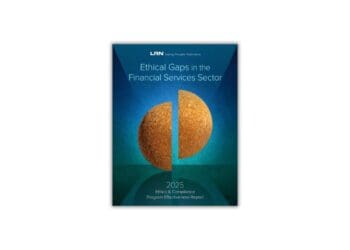While half a million dollars in fraud might not seem like a lot of money in the tech world, the indictment of Mansueto Ventures’ director of people and resources last month by federal prosecutors is a reminder of the two most important elements in preventing misconduct: Values and governance — the “G” in ESG. These elements are essential to preventing ethical disasters and to building a vibrant, sound corporate culture. LRN’s Susan Divers says that too often, these two factors are neglected by both executives and investors, especially in industries like media that are experiencing a multitude of external stressors.
Nirvani Sabess, the former HR director of Mansueto Ventures, publisher of Fast Company and Inc. magazines, was arrested in May, accused by federal prosecutors of stealing more than $425,000 from the media company. Prosecutors allege she diverted money to her personal bank accounts by wrongly paying employees who were on leave or had left the company and then collecting their paychecks.
Ho-hum case or a serious warning? Consider other recent cases, such as Sam Bankman-Fried’s continuously unfolding billion-dollar disaster at FTX. Or the fraud-embracing spree of Elizabeth Holmes, CEO of a once-well-funded startup who reported to prison a few weeks ago to begin her 11-year sentence. Or the former CEO and HR director of McDonald’s, accused of covering up for each other’s ongoing sexual harassment of employees.
Taken together, these cases illustrate that the question of how to set standards for executives and hold them accountable when they fall short is worth discussing.
What these situations have in common is a lack of values (starting with integrity and honesty) coupled with a lack of good governance in the form of systems and processes that mitigate risk and provide assurance that business is being done consistent with company values. The lack of one is bad enough, but the toxic combination of the two missing simultaneously nearly always leads to disaster. Yet many company executives and investors pay insufficient attention to them.
Let’s look at the role of values, especially the importance of the “G” in ESG.
How to Protect Precious IP From Layoff-Related Insider Theft
2023 has seen dozens of companies issue layoffs, and some predictions call for even more through the end of the year. Aside from a potential loss of institutional memory, companies undergoing a reduction in force also open themselves up to another threat: trade secret theft.
Read moreDetailsValues
Values may sound like an old-fashioned or academic concept, but truth, integrity, respect and justice are the foundations for business and its institutions. LRN’s 28 years of research into effective ethics and compliance has consistently demonstrated the power of values. Focusing on building trust, embracing integrity, embedding respect in the workplace, speaking up and listening up without retaliation and ensuring organizational justice at all levels of organizations enable companies to weather stress successfully.
LRN’s research further shows that values strengthen ethical behavior much more effectively than rules. Rules play a necessary role, but they are not self-executing. Our research shows conclusively that an organization’s ethical culture determines whether rules will be observed or not, as well as “eating strategy for breakfast,” as Peter Drucker famously remarked.
According to our 2023 ethics and compliance program analysis, 84% of the 1,800-plus global respondents reported that they relied on company values to get through challenging times. Further, 87% reported that their ethical culture emerged stronger because of their experience. For example, during the pandemic, companies such as Braskem USA saw their employees voluntarily self-isolate in plants for months at a time to keep the electric grid running. Such behavior was motivated by values, not mandated by rules.
Relying on five-pound rule books to influence behavior encourages employees to game the system by finding exceptions and frequently fails to promote individual accountability. In contrast, a values-based approach asks, “should you do this” alongside, “are you allowed to do this?” The current controversies over algorithms that promote potentially harmful content for vulnerable teens (or other undesirable effects) graphically demonstrate the limits of rules and the potential for values to offer solutions. When an employee asks, “I can do this, but should I?” that employee is faced with a gray area not covered by a rule.
Making it clear to everyone — whether it’s the board, the C-suite, managers or employees — the values that define the organization puts them on notice that this is the way things are done.
Governance
The other necessary component, the “G” in ESG, includes the systems, processes and accountability to ensure that those values aren’t merely words written on a page. The apparent gullibility of well-established and successful investors in companies such as FTX or Theranos show the need to trust but verify, going beyond lofty CEO rhetoric and promises to make the world a better place, to see if the internal housekeeping is in order.
One of the key starting places for good governance is assurance — or internal audit. It’s hard to believe that even a senior executive, in the case of Mansueto, could have hidden and diverted to personal accounts a succession of fraudulent payments over the span of several years. Ensuring a robust and thorough internal audit function that tests systems regularly, checks that policy and processes are followed, understands the personalities of department heads and ensures accurate reporting is foundational to good practice.
Another more challenging component of good governance is organizational justice. Employee perceptions that the company is fair in allocating both rewards and sanctions is both a foundation and a driver of ethical culture. Research shows that employees obey authority when they think the organization is ethical and evenhanded, thus earning moral authority. Studies also show that employee perceptions of overall workplace fairness strongly correlate to occurrences of misconduct — the less perceived fairness, the more misconduct and vice versa. Thus, failure by an organization in this critical area is costly. It undermines an E&C program’s entire edifice.
Companies can take concrete steps to drive organizational justice. One is to develop and embrace transparent and clear standards for determining workplace rewards and sanctions, including hiring and firing, promotions and demotions, bonus calculations, pay-raises or decreases, transfers to other units, vacation days, work expectations and work schedules, job assignments, performance evaluations and public recognition.
As we have seen in the past several months, regulators have zeroed in on personal accountability, a key component of organizational justice and good governance. In March, the DOJ announced a three-year pilot program that has two main components. First, every corporate settlement of a DOJ misconduct investigation will include a requirement that the company develop and deploy compliance-promoting criteria within its compensation and bonus systems, including clawback provisions to recoup bonuses and compensation in the event the recipient participated in misconduct. Second, if and when a company uses its clawback procedures to penalize wrongdoers, the pilot program will provide fine reductions to those companies.
Even if a company isn’t facing federal prosecution, taking steps to embed personal accountability into its incentives system and using clawbacks when misconduct occurs is part and parcel of good governance. Mansueto Ventures may want to take note. To their credit, once the fraud was uncovered — four years into the scheme— Mansueto Ventures acted swiftly, decisively and correctly. But there is surely still work to do to recalibrate values, systems and processes to elevate accountability.
Yes, trust. But also verify.




 Susan Divers is a senior adviser with LRN. In that capacity, she brings her 30-plus years of accomplishments and experience in the ethics and compliance area to LRN partners and colleagues. This expertise includes building state-of-the-art compliance programs infused with values, designing user-friendly means of engaging and informing employees, fostering an embedded culture of compliance, and substantial subject matter expertise in anti-corruption, export controls, sanctions and other key areas of compliance. Prior to joining LRN, she served as AECOM’s assistant general for global ethics and compliance and chief ethics and compliance officer. Under her leadership, AECOM’s ethics and compliance program garnered six external awards in recognition of its effectiveness and Divers’ thought leadership in the ethics field.
Susan Divers is a senior adviser with LRN. In that capacity, she brings her 30-plus years of accomplishments and experience in the ethics and compliance area to LRN partners and colleagues. This expertise includes building state-of-the-art compliance programs infused with values, designing user-friendly means of engaging and informing employees, fostering an embedded culture of compliance, and substantial subject matter expertise in anti-corruption, export controls, sanctions and other key areas of compliance. Prior to joining LRN, she served as AECOM’s assistant general for global ethics and compliance and chief ethics and compliance officer. Under her leadership, AECOM’s ethics and compliance program garnered six external awards in recognition of its effectiveness and Divers’ thought leadership in the ethics field. 









